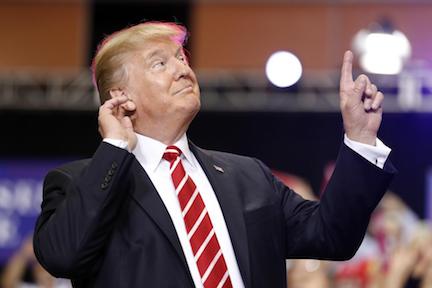President Donald Trump loves tariffs so much he once called himself “Tariff Man.” He also has repeatedly portrayed the punitive tariffs he has imposed on China and other countries as tools to create leverage and draw them into new trade deals that benefit the U.S.
Increasingly, however, Trump’s tariffs are looking like an end-goal rather than a tool and more tangible than any of the deals the president has promised. And that, economists agree, bodes badly for the U.S. and global economies.

In tweets and other public utterances in recent days Trump has hailed his tariffs, claiming they have helped power U.S. economic growth and repeated over and over again that other countries such as China foot the bill, a view even his own economic advisers are uncomfortable defending.
Trump is also displaying a preference for his tariffs over his own deals.
Among the major hurdles to a congressional vote to ratify his renegotiated version of the North American Free Trade Agreement are the steel and aluminum tariffs that Trump imposed on products coming from Canada and Mexico.
Those tariffs have invited retaliation against U.S. agricultural exports such as corn and pork that are hurting U.S. farmers. They also have caused senior Republicans like Chuck Grassley, the powerful head of the Senate Finance Committee, to say they will block any vote for Trump’s re-branded Nafta, the U.S.-Mexico-Canada Agreement.
But Trump has refused to bend unless Canada and Mexico agree to other trade restraints with new investment in domestic steel mills and aluminum smelters one of the benefits of Trump’s trade wars the president is most eager to tout.
“In one year Tariffs have rebuilt our Steel Industry - it is booming!” he said on Twitter on Tuesday. “We now have a big and growing industry. We had to save Steel for our defense and auto industries, both of which are coming back strong!”
It’s that sort of proclamation that has analysts concerned that Trump’s tariffs may be the real end-goal of his trade agenda and thus risk becoming a permanent fixture.
“Deals, deals, deals. The real deal is standing up to foreigners who have been eating our lunch from his perspective. And that means imposing tariffs,’’ said Gary Hufbauer of the Peterson Institute for International Economics.
Beyond the higher costs they impose on U.S. companies and consumers, Trump’s new tariffs are also inviting more retaliation.
‘Law of the Jungle’
On Monday, China laid out plans for an increase of tariffs by as much as 25% on some $60 billion in imports from the U.S. The EU has said it will retaliate quickly against any U.S. auto duties with the bloc’s trade commissioner, Cecilia Malmstrom, on Monday accusing Trump of taking a “law of the jungle’’ approach to trade.
Hufbauer and others argue such an escalation in a tit-for-tat tariff war would hurt not just the U.S. economy but the global economy as a whole. While the direct impact of tariffs might seem manageable—Hufbauer’s own back-of-the-envelope calculation is that tariffs on all Chinese imports would cost U.S. households roughly $2,000 per year in higher prices—a broader economic slowdown would be far more painful.
Trump’s claim that his tariffs have boosted U.S. growth is based in part on a transitory drop in imports related to the stockpiling by U.S. companies at the end of last year of goods from China facing higher tariffs. Advocates of tariffs also claim they encourage domestic investment and thus pay long-term dividends.
Put to the Test
With his tariffs Trump has launched the world’s largest economy into a live-fire experiment to see if that is true. Or whether what most economists see as the lessons of history still hold.
Economists have long argued tariffs lead to higher costs for American consumers and companies while also hitting growth overseas, a toxic mix for the U.S. that could even tip it into a recession.
“I’m with most economists and I think tariffs and a reduction in free trade are going to be a bad outcome for all involved and not just the U.S.,’’ said Stephen Gallagher, chief U.S. economist at Societe Generale SA in New York. In a note to investors this week Gallagher argued that an extension of a 25% tariff to all imports from China could lop 0.5 percentage point off U.S. growth.
There’s another looming tariff reality worth considering, Hufbauer said. The politics of tariffs and the vested interests they create mean tariffs are easier to impose than to remove.
Lifting his steel tariffs or any of those he has aimed at China already seems increasingly difficult for Trump. One sticking point in negotiations with China has been Trump’s refusal to remove existing tariffs if a deal is struck, something Beijing insists on.
But eliminating tariffs may also be hard for anyone who succeeds Trump, Hufbauer said.
The best example, according to Hufbauer, is the 25% tariff that has long protected light trucks in the U.S. from foreign competition. It was introduced in the 1960s to retaliate against European measures aimed at American poultry and has survived multiple U.S. presidencies. Ergo the name of a once-temporary measure that now seems awfully permanent: the chicken tax.











